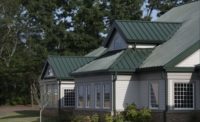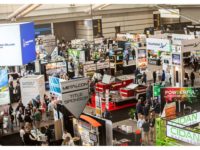Library Uses Metal Roof to Highlight Design






When officials in Lilburn, Ga., planned the new double-duty library and city hall building, the vision called for interior spaces that provided ease of access and circulation within the structure, with a shared lobby space on the first and second floor. On the exterior, the design called for steep-slope roof elements that would draw attention to certain building functions and entry locations, and metal roof panels to accentuate these spaces.
“We wanted a quality roofing product that would last a long time and meet FM requirements. Metal gives us the ability to create visual interest while providing protection from weather,” said Lance Davis, AIA, assistant vice president, Precision Planning in Lawrenceville, Ga., who was the lead architect on the project. Roughly 10,000 square-feet of PAC-CLAD Tite-Loc Plus 16-inch-wide panels in 24 gauge steel finished in Sierra Tan color were installed.
“PAC-CLAD metal roof products were specified because they’re reliable, nice-looking products that perform very well and meet stringent requirements,” Davis said. Soffit and trim pieces were fabricated from Petersen’s PAC-CLAD flat sheet.
The clock tower is one architectural element that draws attention to itself. The height and pitch of the clock tower’s roof presented challenges for the installation crew, said Ryan Rebstock, regional operations manager for Nations Roof in Lithia Springs, Ga. The pitch is 8:12 and is elevated roughly 80 feet in the air, which required all roof work to be performed from a 120-foot mechanical lift, Rebstock said.
“The clock tower roof assembly was completed on the ground, but we could not have installed panels on ground because of the rigging needed to hoist it into position would have required us to cut holes in the panels. So, we took panels up two at a time, installed them, then came down for more panels. We had to hand-seam the clock tower roof because of the extreme roof pitch and weight of the seamer. It wasn’t a large amount of metal on the tower but it took a few days to install with all the up-and-down,” Rebstock recalled.
“The rest of the roof on the building wasn’t as steep, but seaming was done by hand because the crew preferred to do it that way. By the time the crew became used to seaming by hand on the steep sections, they developed a nice rhythm so they continued that way,” he said.
As a new construction project the jobsite was busy, making it difficult for the roofing crew to operate efficiently among the activity of multiple trades. The Nations Roofing crew worked with the general contractor to gain access to a critical area of the jobsite at the most critical time.
“The parking area was congested on the ground. There were a lot of different trades on site, and it was a constant struggle to keep people out of our designated area,” Rebstock said. “Other trades were moved around and pushed off a day to get us in when we really needed our space. Especially around the clock tower installation the GC helped keep us as the priority.” Nations Roof was on site for roughly eight months, completing work in phases, each of which required its own set-up and takedown process.
Rebstock believes Petersen makes good products, and that the manufacturer’s technical support was equally important. “From shop drawings to making sure we ordered correctly to being on site, the Petersen rep made sure everything was going smoothly. He helped us at every step. And when a panel was mis-cut, Petersen jumped through hoops to get us the replacement we needed and keep us on schedule. Petersen technical representatives were true partners with us in helping get past many challenges. PAC rep Dave Landis went to all the meetings with us and helped us clear all the hurdles at every step of the process.”
Looking for a reprint of this article?
From high-res PDFs to custom plaques, order your copy today!



.jpg?height=200&t=1713956980&width=200)




